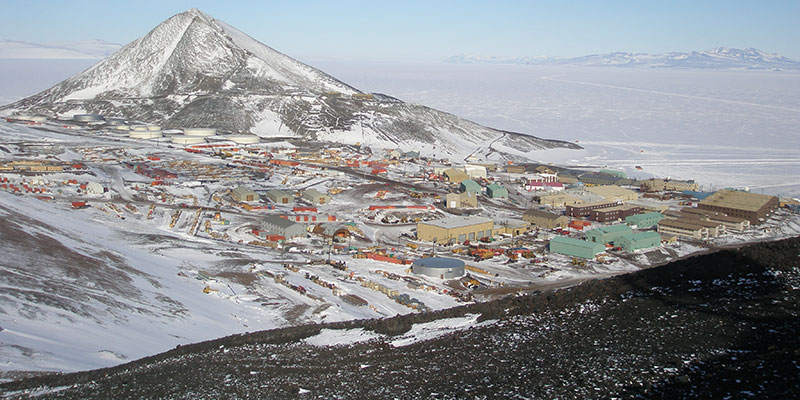The McMurdo Station in Antarctica has a $6 million, 170-by-140-foot indoor facility to treat the station’s wastewater to U.S. standards.
Remote outposts use decentralized treatment to reach standards of their home countries
At Fluence, our passion for decentralized wastewater treatment draws inspiration from those who make decentralized treatment work in even the most remote and forbidding environments, allowing researchers to thrive and work where never possible before. You can’t get much more remote and forbidding than Antarctica, and in terms of decentralization, you can’t get much farther from centralized treatment than the southern tip of the Earth.
Ninety-eight percent of the 5.483 million square-mile (14.2 million km2) continent is covered in ice. Every year, 27 nations send visiting researchers and support workers to Antarctica, giving it a seasonally variable population of between 1,000 and 4,000, divided among several stations and camps.
A key step in promoting wastewater treatment in Antarctica came in 1991 with the Madrid Protocol of the Antarctic Treaty nations, which established sewage treatment and disposal standards. It stipulates that wastewater and solids that cannot be discharged or reused be shipped for disposal to the home country of a particular outpost. Here is how a few of the dozens of stations are dealing with their wastewater challenges:
- McMurdo Station: The United States’ McMurdo Station is the largest of the Antarctic stations, and it has a $6 million, 170-by-140-foot indoor facility to treat the station’s wastewater to U.S. standards. The plant handles an unusually high load of solids. In the absence of screens or primary clarifiers, flow goes through grinders that shred rags, plastics, and trash and moves the waste on to dewatering. Storage tanks are used to manage highly variable flows at the station (its tiny population of 150 in the winter balloons to 1,000 during the summer). The flow finally undergoes UV disinfection, and, after secondary treatment, the remaining dried solids are shipped to the U.S. for disposal.
- Concordia Research Station: Concordia’s wastewater treatment system was developed from the European Space Agency’s (ESA’s) Micro-Ecological Life Support System Alternative program, code named Melissa, which develops regenerative life support systems for space missions. At the French-Italian station, grey water is recycled back to hygienic water starting with nanofiltration moving on to filtration through two more membranes. For the final touch, reverse osmosis is used, allowing the station to reclaim about 85% of its wastewater. Melted snow replaces the remaining unusable 15% that must be shipped off-continent.
- Amundsen-Scott South Pole Station: To supply drinking water, the U.S. Amundsen-Scott South Pole Station uses Rodriguez wells, which are cavities hundreds of feet below the ice, where a reservoir of heated water is maintained and continually melts its way downward, forming a bulb-shaped space. Once the bulb space is about 500 feet (152.4 m) deep, it requires too much energy to pump the fresh water up, so the retired bulb then becomes the new storage space for the station’s sewage outfall. The newest bulb is expected to be large enough for 10-15 years’ worth of sewage.
- Princess Elisabeth Station: This zero-emission Belgian station has a focus on water reuse. Its computer-controlled system recycles up to 75% of its wastewater. An upper storage tank for black water macerates solids and pumps them to an anaerobic bioreactor, heated partially by thermal solar panels, where insoluble material is continually filtered. The bottom tank routes grey water to an aerobic bioreactor where sludge is aerated to aid nitrification and denitrification. Then, nanofiltration and carbon filtration are applied. Before tank storage, the wastewater’s acidity is regulated and it undergoes UV and chlorine disinfection. The unusable portion is shipped off-continent. Princess Elisabeth Station requires people on antibiotics to use a separate toilet to prevent antibiotics from killing the microorganisms that do the work in the activated sludge system.
Feats of Adaptation
The ESA considers survival in an environment as hostile to human life as Antarctica akin to survival on Mars, and some would say the pioneers of Antarctica are almost as adventurous as astronauts. But wherever humans settle, wastewater treatment must eventually follow.
Contact Fluence to learn more about our disruptive technologies that make sustainable treatment possible in even the most forbidding environments, with Smart Packaged wastewater solutions that easily ship by truck, train, or ice breaker.

